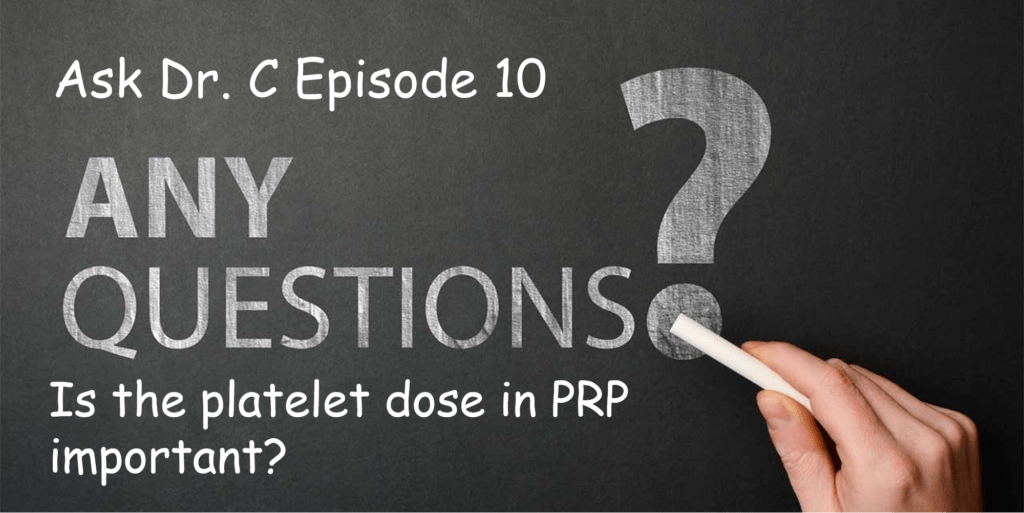Ask Dr. C-Episode 10-PRP Concentration and Age

Sometimes I get questions for the Ask Dr. C Blog that are so good, they blow me away. This morning is a question like that. Let’s dig in.
“I read that PRP study and noticed a few interesting things. They were using pretty weak PRP, only about 1.5-2.5x over baseline. One of their conclusions was that PRP was less effective in older patients, but could it be because of their low platelet concentration? They also found that multiple injections and injection into the subchondral bone was more helpful for delaying knee replacement, which is good to know, but why would they compromise it with such weak PRP?”
I love this question because it brings out the fact that PRP is not all the same thing as it’s being used out there in clinics. In fact, from clinic to clinic, there are times when it might as well be a different product altogether. So there are a couple of critical points when looking at PRP:
- PRP Type
- PRP Concentration
- PRP Application
What is PRP?
PRP stands for Platelet Rich Plasma. That means that blood is taken and then the platelets in that blood are concentrated. Why do this? The platelets have growth factors and other things that can help tissues heal. Hence PRP is used to help damaged joints, tendons, and ligaments heal or function better.
What Are The Different Kinds of PRP?
PRP Type
PRP comes in many different forms, but here we’ll talk about the injectable forms. In this category, we have red and amber types. Leukocyte-rich PRP, which contains more white and red blood cells is red. Leukocyte poor PRP is amber and contains very few red and white blood cells.
Why should you care if your PRP is red or amber? The research is back and forth on the issue of which is best for which problem. Right now the data leans in the direction of amber PRP working better for most applications. One place where that may not hold is for use in the disc, where our research shows that red PRP is better as it helps fight infection of specific bacteria that usually causes discitis.
PRP Concentration
PRP concentration has to do with the number of platelets in the sample over the baseline concentration in the blood. Meaning, if the platelet count was initially 200 and the PRP has a platelet count of 600, then that’s 3 times (or 3X) concentration. I’ll dive into the importance of platelet concentration below.
PRP Application
PRP isn’t magic in that you inject it somewhere in the vicinity of where it needs to help and that works. In fact, it needs to be placed at the exact spot where you want to enhance repair. Hence, using imaging guidance and advanced injection skills is critical in whether PRP works or doesn’t work. 99% of the physicians offering PRP do not have these skills.
PRP Efficacy and Older Patients
So if PRP concentration is like the dose of a traditional medication, does age impact the dose needed? Yes, in a HUGE way. Let’s dig in.
We first began noticing PRP’s impact on younger and older cells when we were using platelet based products to help culture (grow) mesenchymal stem cells (MSCs). We noticed that if the patient was young, their MSC growth would max out at low concentrations of their own platelets. Meaning, exposing their cells to 10X PRP stimulated no more growth than a 2X PRP. However, if the patient was old, there was a direct dose-response. Meaning that 2X PRP would get X growth, but 4X would stimulate 2X growth, and 20X would stimulate far more growth than 4X.
We then ran formal experiments with tendon cells, since PRP is used quite a bit to treat tendon problems (1). Again, we saw that higher PRP doses added little additional benefit in younger patients, but that was totally different in older patients. In that group, higher PRP doses stimulated much more healing than lower doses.
Back to the above question, YES, the observation that older patients didn’t do as well with 1-2X PRP (very low dose) is consistent with our published research. In our experience, you would need at least 5-7X PRP in older patients and the higher the concentration the better, Meaning at Regenexx, we often use 14-20X PRP in the knees of older patients.
Hence, a PRP study that had older patients who didn’t respond to 1-2X PRP doesn’t tell us much and shows that the authors of the study didn’t know much about the PRP research or how PRP works. The fact that a patient picked up on that is just amazing! So congratulations on becoming a PRP expert who is now smarter than the doctors who did that study!
The upshot? When you see the term PRP used by a clinic, be very careful as that means lots of different things. Some will work just fine, especially if you’re younger. However, if you’re middle-aged or older, what’s in the PRP makes a HUGE difference as to whether you will respond to treatment.
_________________________________
References:
(1) Berger DR, Centeno CJ, Steinmetz NJ. Platelet lysates from aged donors promote human tenocyte proliferation and migration in a concentration-dependent manner. Bone Joint Res. 2019 Feb 2;8(1):32-40. doi: 10.1302/2046-3758.81.BJR-2018-0164.R1. PMID: 30800297; PMCID: PMC6359887.

If you have questions or comments about this blog post, please email us at [email protected]
NOTE: This blog post provides general information to help the reader better understand regenerative medicine, musculoskeletal health, and related subjects. All content provided in this blog, website, or any linked materials, including text, graphics, images, patient profiles, outcomes, and information, are not intended and should not be considered or used as a substitute for medical advice, diagnosis, or treatment. Please always consult with a professional and certified healthcare provider to discuss if a treatment is right for you.